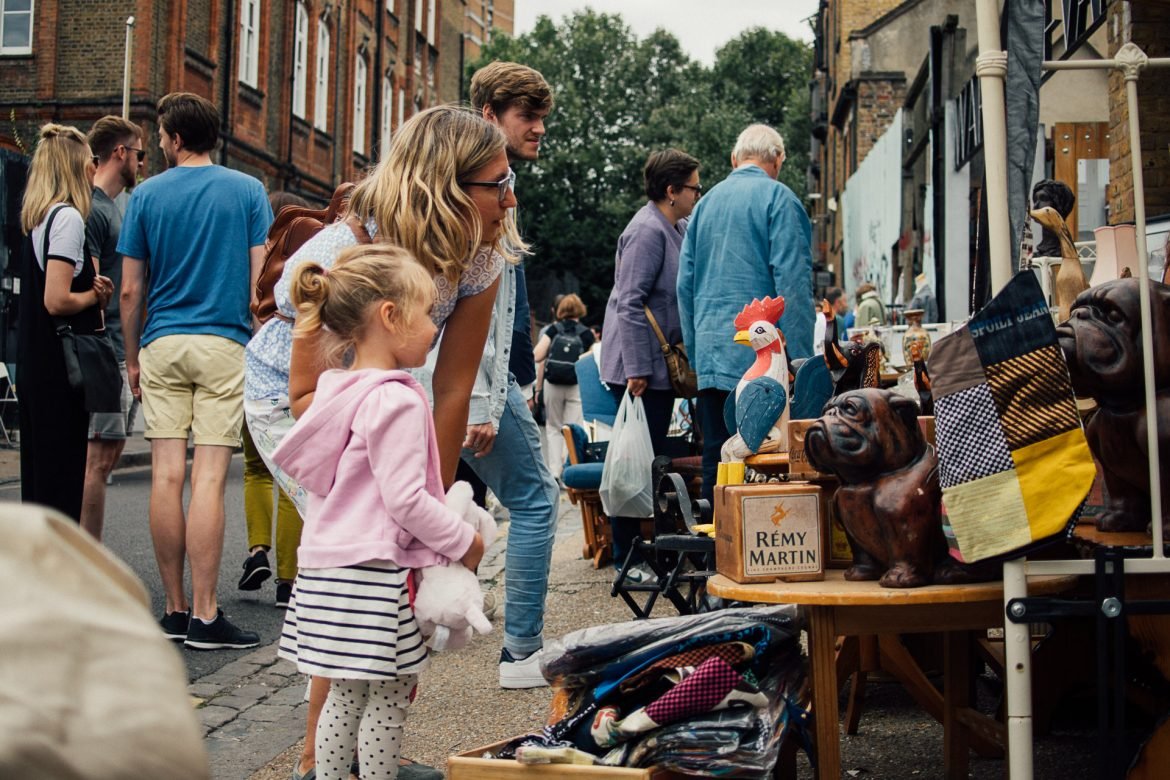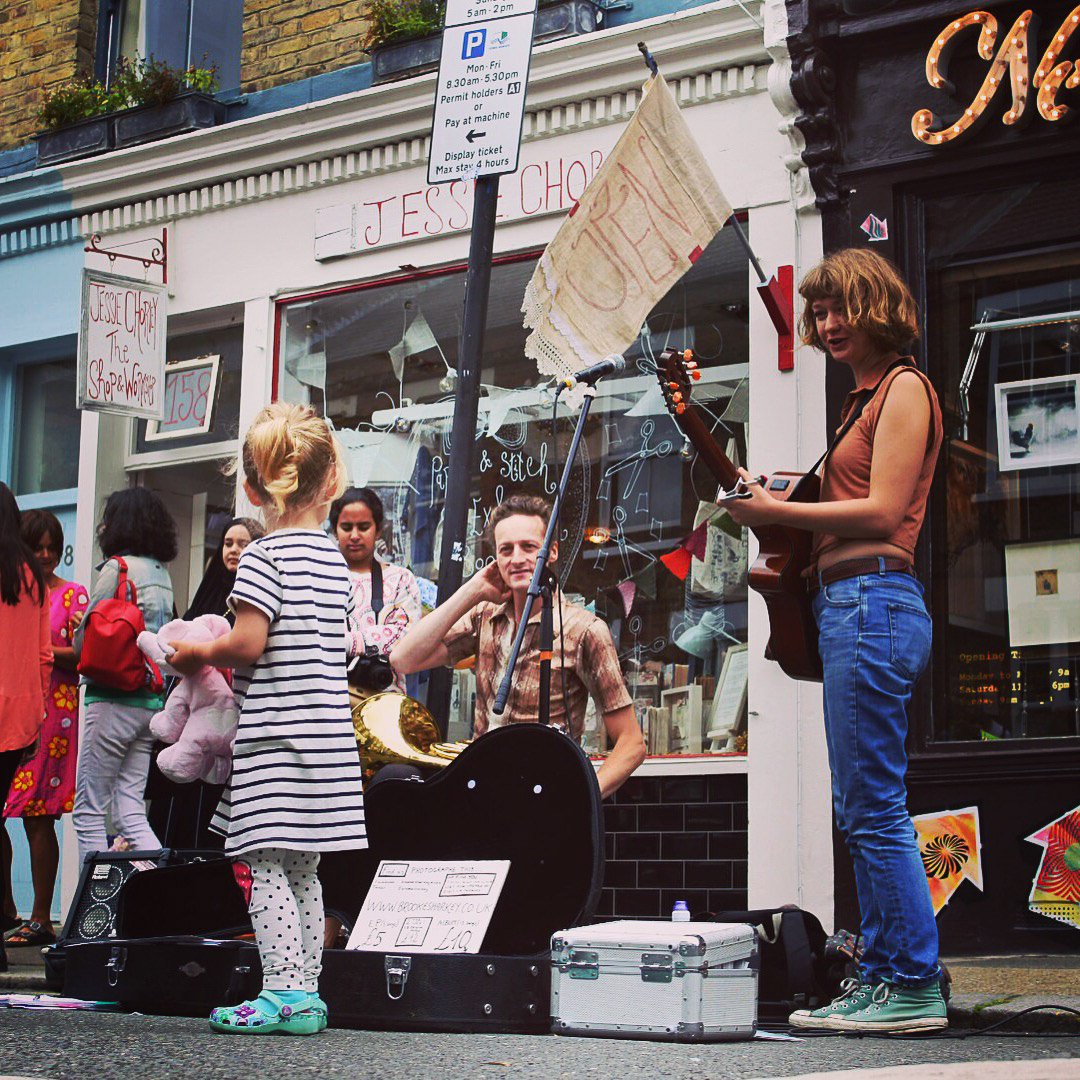Columbia Road Flower Market is located outdoors in the street with the same name, in East London. It was originally established as a fish market in 1869, but over the years it evolved with the neighbourhood to become a hugely popular market for flowers, plants, and other garden staples.

Many of the stallholders hail from families who have sold at the market for generations; prices are reasonable, the selection is second to none, and the sales patter is fun and engaging. Visiting Columbia Road Flower Market is a unique London experience that should not be missed, even if you don’t particularly need any plants. Be warned, even those without a touch of a green thumb will find it hard to resist bringing something lovely home from this fragrant market.
5 Highlights around the market
- Bob & Blossom – adorable and uniquely designed children’s clothes
- Cafe Columbia – fantastic bagels in a friendly and relaxed atmosphere
- Campania – small menu of the most delicious Italian favourites
- Laxeiro – big tapas portions of galician specialities
- Nelly Duff – local gallery featuring art at reasonable prices
Fresh flowers at a good price
The flowers offered at Columbia Road Flower Market are seasonally influenced, so in the spring and summer, tulips and peonies abound. Sunflowers pack the market come autumn, and by the time the Christmas season rolls around, holly, mistletoe, and holiday wreaths are everywhere.
You can find cut flowers of the freshest and best quality at the market for about the same price as you would normally pay for the uninspired and somewhat tired cello bags of flowers you see at grocery stores. The vendors vie for your trade here, calling out the special deals and incentives in hopes of getting your attention and your patronage.

Grow a herb garden
Gardeners from all over come to Columbia Road Flower Market for potted plants and other garden favourites. Herbs like lavender, dill, and basil stand ready in their little pots for you to whisk them away to your kitchen garden.
You can buy rose bushes, olive trees, or lemon trees for your garden. There is a stall at the market selling special orchids and Mediterranean shrubs for both indoor and outdoor decorating.
Columbia Road Market is a treat for the senses and makes for an unforgettable Sunday morning in London.
The History of Columbia Road Market
Tucked away in a small street in the heart of London’s East End, Columbia Road is a magical world of colourful plants and exotic flowers, with 52 plant stalls and 30 or so garden shops and cafes. Old and new merge wonderfully together to create an atmosphere that visitors cannot resist.
Columbia Road Flower Market began its life in the 119th century – but not as a flower and plant market. In the early years, the market was an informal mix of stalls selling all kinds of available produce, scattered along the full quarter-mile of Columbia Road.
In 1864 the philanthropic Baroness Angela Burdett Coutts had the idea of building a market square within Columbia Road to provide cheap food and fish from the then-thriving East coast ports. Her plans included a sizeable Gothic-style building with shops and flats above the shops to provide cheap accommodation for the traders.
The plan depended on the extension of the railway track to route from the railway to Bishopsgate, along the centre of Shoreditch High Street, then directly into Columbia Road Market. Unfortunately, due to planning objections, the railway did not materialise, ending Baroness Angela Burdett Coutte’s plans.
The Columbia Market square failed miserably, and traders wanted to return to the length of the street, where they were free from the regulations and regimentation for the square.
The Columbia Market Building became industrialised and used as warehouses. As Jewish immigrants moved into the area, they moved into the warehouse to practice their industry, mostly cabinet making. As a result, most shops along Columbia Road became small factory units and family businesses making furniture. In addition, two more giant factories sprung up, one on each side of Columbia Road School.
Over the years, most market traders selling general goods gradually moved over to Petticoat Lane Market, which immigrant Huguenots, the lacemaker, had previously established, and from which the market derived its name.
The traders remaining in Columbia Road tended to congregate to sell their wares within the 300 yards between the two pubs – The Royal Oak and The Birdcage. During these early years, there had been no Sunday trading for markets or shops due to the observation of Sunday as the Sabbath. However, following the influx of Jewish immigrants whose holy day was Saturday, the Jewish traders could not work. An application was made to Parliament to allow trading on Sundays – This eventually became statutory. As Sunday trading became established, the weekday market at Columbia Road disappeared.
With the Sunday market more established, cut flowers and plants became more prominent as Covent Garden and Spitalfields cleared their stocks on Saturdays. Traders also brought in stock from nurseries in the countryside.
In 1927 traders became licensed to trade in specific goods on specified pitches. Columbia Road market became specialised in flowers, plants, trees, bulbs, etc., and anyone selling other goods was gradually retired.
During the Second World War, there were restrictions on producing plants and flowers. There was a Dig for Victory campaign to produce homegrown foods as imports were heavily restricted. After the war, trading became more concentrated within the short street, the pitches were pushed closer together, and carts and vehicles were not permitted. Trading became very seasonal but very intense, with March to July and September to December being the busiest times. This made the market was and wane in size, with traders turning up when they thought it would be worthwhile.
Today the market is entirely different. In the ’60s, the council imposed a four-week rule which meant a trader would lose his license if he failed to appear at least once in four weeks. The traders then increase their attendance.
This rule created all-year-round trading. As a result, imports from Holland and other countries became easier to obtain. In addition, plastic flower pots replaced heavier clay pots, and plastic trays replaced wooden ones. Therefore transporting plants was less of a problem.
Columbia Road Flower market exploded into action. Derelict shops nearby were taken over, benefiting from the increased trade in the area.
The market is now visited by 1,000s of garden enthusiasts every Sunday throughout the year, searching for rarities or general plants at wholesale prices. At six each Sunday morning, the sleepy street comes alive as traders start unloading their lorries. The stock and prices change every week. At 8 am, trading starts and carries on until 2 pm.
Key Information Columbia Flower Market
- Outdoor
- Type: Market
- Borough: Tower Hamlets
- Area: East London
- Tube: Shoreditch High St.
- Nearby: Hackney City Farm
- Market website
















